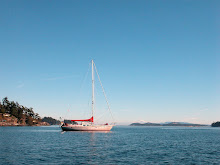We stopped at Mushamna, on our way out of Woodfjord, mainly because the anchorage, a completely sheltered lagoon with a tight entrance, sounded intriguing. The entrance between two sandbanks was very narrow and with all eyes glued to the depth sounder, Snow Dragon slowly made her way in. Depth turned out not to be a problem and it took some time to find a suitable anchor spot in the deep lagoon.
After dinner we wandered over to the large abandoned cabin that we noticed on our way into the bay. As we walked down the hill, Frances thought she saw a dog near the cabin but it did not seem to be moving and she concluded that it must be a piece of furniture. After negotiating the river that separated us from the cabin we were surprised to see a person walking around the cabin.
A woman motioned for us to go around the other way, moving her arms up and down to indicate that there were birds in the area that she wanted us to avoid. Later explaining they were recently hatched eider chicks, well camouflaged and easy to step on. She introduced herself as Tove but we came to know her as the “Summer Substitute Trapper Lady”.
After giving us a tour we settled down outside in the warm sunshine with wine and homemade apple cake as Tove told us about the cabin’s history. It was built by a trapper who used the cabin extensively for ten years before selling it to the Sysellmennen. Tove was substituting for a friend who had permission to use it for a year. Though trappers continue to be interested in using the cabin and are even willing to pay to be there, the Sysellmennen is closing it down for a season in order to discuss its future.
One criticism we heard repeatedly during our time in Spitsbergen is that the Sysellmennen’s regulations let buildings deteriorate that otherwise could be put to good use. The cabin at Mushamna is not old enough to be considered an historical site and it is really unclear why the cabin cannot continue to be used while various possibilities are debated. Trapping is an important part of Svalbard’s history and a tradition that residents feel should be kept alive.
Anyone who stays there must be completely self sufficient and be prepared to deal with frequent polar bear visits. Including hungry bears who really don’t care how much fire power you have. The reward is being able to live and trap in a spectacular area. Along with breath taking scenery, the cabin’s beach log construction gives it a wonderful character that matches the fjord. Its unusually spacious interior makes it very comfortable but difficult to heat during the winter.
Our time in Svalbard was soon coming to an end and so was Tove’s. After spending several years living in both Longyearbyen and Ny-Alesund, Tove decided to move back to Trondheim where she grew up. We have to agree that spending several months in a remote cabin is a special way to say goodbye to Spitsbergen.
The following morning we anchored Snow Dragon near the cabin and Tove came on board for brunch. Over scrabbled eggs, bacon, fruit and fresh baked orange muffins we continued our conversation from the previous night like old friends. It would not surprise us if Tove ends up spending time on Snow Dragon and we certainly plan to accept her invitation to visit her in Trondheim.

For more photos please click on Mushamna Album.


No comments:
Post a Comment